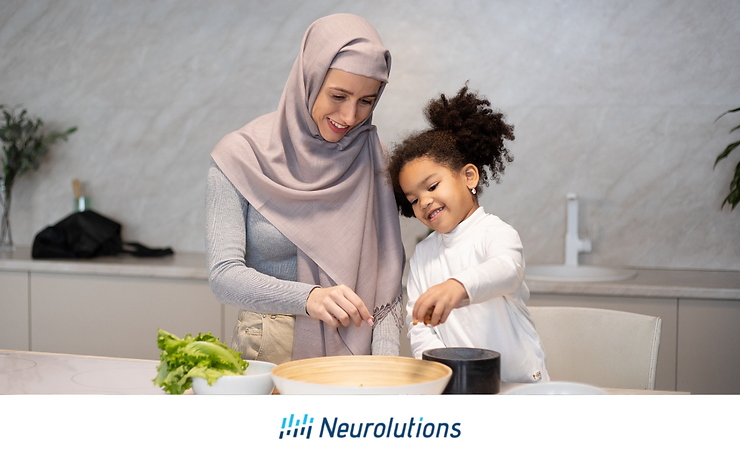Completing any task one-handed can be very very challenging, especially when it involves a multistep process or dynamic activity that previously required two hands. For instance, most people brush their teeth one-handed at baseline, but very few have had every chopped vegetable or made an oven-roasted chicken one-handed. Fortunately, there are many tricks and adaptive equipment which can help make a one-handed activity less frustrating and more efficient.
First things first. Set up the environment for success. It is important to implement the use of energy conservation (prevention of wasteful energy) and work simplification (making tasks as easy on yourself as able) strategies when completing cooking tasks post to increase the ease and safety of the activity. The following suggestions are ways to optimize the environment.
Modified Environment for Cooking With One Hand
Set Up A Modified Environment With Stations.
- Have all items that need water next to the sick or items that will go on the stove or oven top placer before beginning to work with them. Make a plan and have everything ready to go to lessen the burden of in-the-moment activity.
Place Items At the Optimal Height Of the Counter Or Wheelchair Height.
- This is to assist with limiting the reach and decreasing the likelihood of falls.
“Sit For Safety.”
- Standing while chopping or mixing while experiencing one-sided weakness is much greater of a safety risk when previous to a stroke. If your balance is of concern and you are able to complete any of these tasks while seated, this helps decrease the likelihood of a fall.
Slide Rather Than Carrying Items.
- This is also a fall prevention technique. If space allows, use the strong arm to push items a foot or so to the next place and then side step one or two feet and continue with this pattern until the object reaches the desired destination.
Use The Microwave Or Stove Top Versus An Oven
- If you have the choice to do so. Bending down into an oven while lifting a large oven-safe dish with one hand can be very difficult. If the recipe is able to be completed without the use of an oven, it will most likely be less burdensome.
Get Pre-Prepped Food
- If able, buy prep-chopped foods or frozen food to decrease meal preparation and focus on the cooking aspect.
Set Timers For Reminders Of When Food Needs To Be Taken Out Or Moved.
- Don’t try to do too many things at once. Setting an alarm can reduce the load on one’s memory while cooking and allow one to concentrate more on other factors related to safety (i.e. control while cutting).
Ask For Help.
- Although this is not a modification to the environment, if a family member or friend is advisable to help, a second person can ease the burden of carrying, using the oven or chopping while the stroke survivor practices skills to increase independence.
Adaptive Equipment for Cooking
- Rocker knife — compensates for the inability to use both upper extremities for a sawing motion required for cutting.
- Built-up utensil — compensates for weakened hand grasp when attempting to use utensils for eating or meal preparation.
- Adaptive cutting board — an adaptive cutting board is fashioned with tools (with nails or piping) to hold the food in place while chopping with one hand).
- Dycem® or non-slip grip items — Dycem® assists plates and cups to remain in place if the individual is unable to hold them with two hands due to one-sided weakness. This can be very helpful if placed under a large mixing bowl when mixing or scooping such as making brownies or a cake.
- Scoop plate — compensates for decreased wrist movement and manipulation of the hand when attempting to scoop or pick up an item off a plate
- Universal cuff — Various kitchen tools can be used with these tools. It allows items to slip into the holder of the universal cuff. The universal cuff allows the user to hold the item without maintaining an active gasp on the item, using the gross motor movement of the shoulder or elbow.
- Pan/pot holders — Heat-resistant suction frames secure to the stovetop and prevent a pot or pan from sliding on the open burner.
- One-handed pouring aids — After a juice or milk jug is placed in the device, the user is able to pour the jug with just a tilt of a couple of fingers or the side of their wrist/forearm. This is helpful for a weak arm or when the user only has one hand available.
- Electric can opener and Electric Everything!!!! — Use of electric appliances can be used to compensate for decreased hand use by completing the task for the user. Most household kitchens contain electric mixers or an electric can opener. Look around! Your kitchen may contain more adaptive items than you think!
|| Learn More — Best Stroke Recovery Tools to Regain Arm Function
Additional Tips for Cooking After a Stroke
- One-handed cooking can be really really scary and intimidating at first. Take a look around your environment and see how well adaptive equipment and devices fit in the kitchen for the survivor to use.
- Working with an occupational therapist in a home or in a clinic setting can be very helpful in problem-solving what will work best. It also can be helpful to bring in a picture of the kitchen setup or a family member to help describe the cooking area and what best ways to help.
- Continue to practice. It will get less intense the more you become familiar with the process.
- Slow down. Rushing can lead to injury, spills, and ultimately feelings of failure. Spare yourself the frustration and time block more than enough time to prepare the meal, cook the meal, and clean up after the meal.
- Start with one to two-step simple recipes such as a premade muffin or cookie mix and ramp up slowly as technique and confidence increase.
- Divide and conquer. If you are cooking with a partner or friend, tackle parts of the meal that you feel most confident in while your partner completes a different meal duty. Cooking and meal preparation can be a great way to be productive rather than watching TV. Your partner may be appreciative of the help, and cooking can be fun!
- For components of cooking that you are not very confident with, have a trusted partner or friend observe you and provide insight/advice to help you improve. You may have enhanced awareness, and it may end up being a confidence builder that you are doing just fine! If safety is an issue, allow your partner to assist with that part alone while you complete the other steps.
- Rightfully so, many individuals shy away from using the oven out of concern that they may drop hot items or burn themselves. Practice bringing dishes (with or without food) in and out of an oven that is NOT turned on. Repeat it over and over again, learning from any mistakes. Consider using smaller and/or lighter sheets/baking dishes to secure them easier with one hand.
- Don’t forget to attempt to use the affected upper extremity to stabilize items if safe to do so.
You’ve got this! Bon appetite and get ready to eat!




